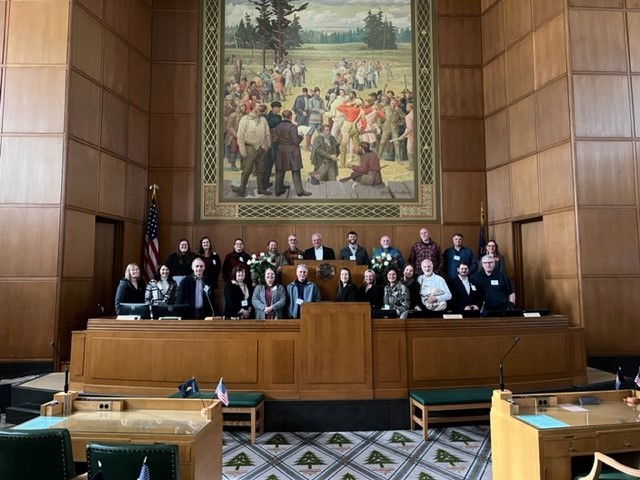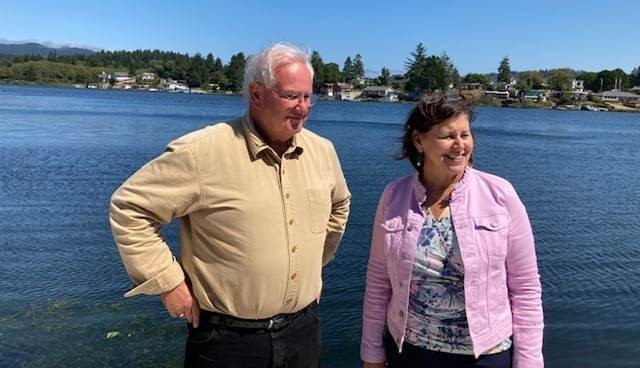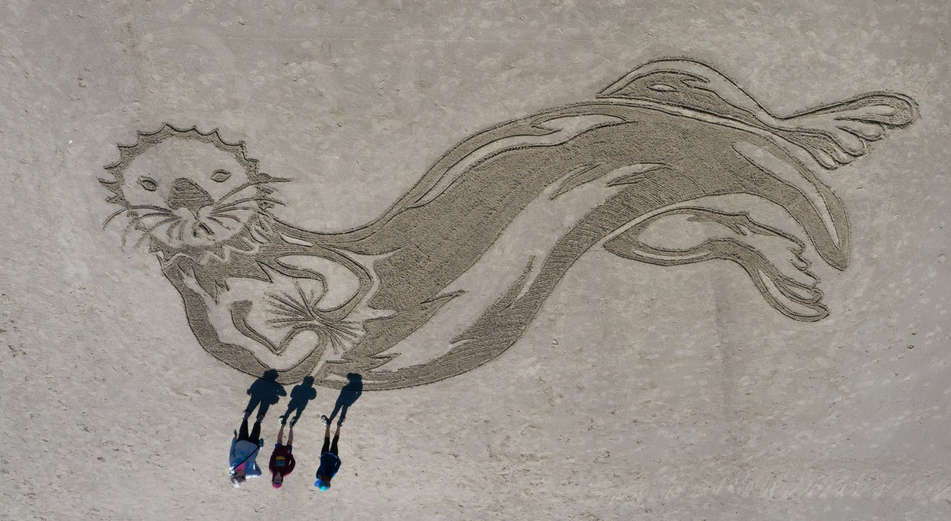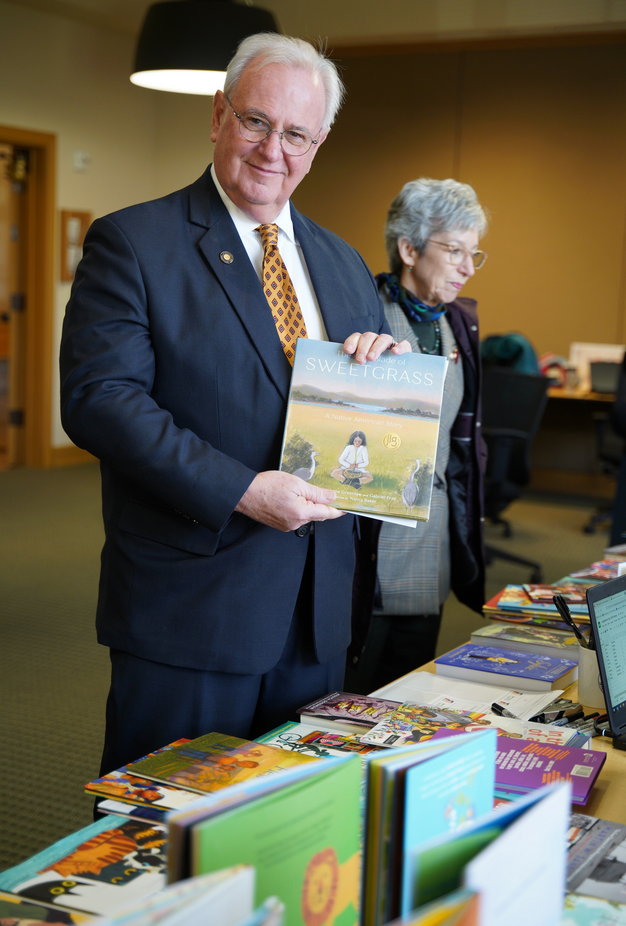By Representative David Gomberg, House District 10
2/20/2023
Hello Neighbors and Friends,
Thursday afternoon, my committee hearing ended early. I often opine that a legislator with nothing to do is the most dangerous person in the Capitol!
I walked over to the House Chamber and there found a group with a Capitol guide standing in the cramped side aisle. It seems I had found “County College”, a program for newly elected county commissioners to help them better understand budgeting, open meeting and ethics laws, and how state government works. But under Capitol rules, no one is allowed onto the House or Senate floor unless accompanied by a legislator.
I was happy to bring the group in, talk about the process, and give them a sense of how it feels to be in the arena.

The two “fast-track” issues this session are housing and semiconductors. Last week I detailed the evolving legislation intended to address homelessness and home affordability. This week let’s look at the semiconductor question.
The special Joint Committee On Semiconductors has completed nearly six weeks of testimony and is now working to craft legislation. Our goal is to pass a package of policy changes and funding proposals by mid-March, in time for the U.S. Department of Commerce to open applications for the federal CHIPS and Science Act, which will provide almost $53 billion in grants and tax credits for semiconductor research and manufacturing to qualifying states.
An economic study predicts that those investments could add 35,000 Oregon jobs and nearly $3 billion in new revenue over the next 20 years.
Overall, we are looking at investing $200 million to grow the state’s semiconductor industry. That’s a far smaller investment than in some other states. New York recently pledged $5.5 billion in state incentives for a single computer chip factory, and Michigan has approved hundreds of millions in incentives intended to attract chip manufacturers.
But Oregon doesn’t need that kind of commitment because of that sector’s long history in the state.
- Oregon ranks first in the nation for the past two decades in computer and electronics manufacturing.
- The state’s high-tech manufacturing workforce operates at a higher level, close to 3 percent, of GDP per job than the average of all industries.
- Model projections show that semiconductor industry expansion could provide high-paying jobs to thousands of Oregonians and increase net revenues for Oregon public services over the next 20 years.
Two newly released studies reinforce the potential statewide benefits of investments within the semiconductor industry. The first survey for the Oregon Semiconductor Coalition pegs industrial land shortages as the main difficulty.
The other study, by ECONorthwest and the Oregon Business Council, says transformational industry investments could create more high-wage jobs, advance Oregon’s manufacturing output, and exponentially grow the state’s economy. This economic growth would benefit Oregonians everywhere, for those both in and outside of the technology and manufacturing fields, as the industry engages a variety of sectors in the supply chain.
A Task Force report released in August of 2022 outlines a strategy to expand this industry and benefit Oregonians statewide.
The evolving legislative plan proposes forgivable loans to applicants devoted to creating a facility, research and development of semiconductors, and partnering with higher education institutions for workforce development. The forgivable loan program would receive an allotment of $200 million.
These housing and semiconductor packages are now being worked in policy committees. Once complete and approved, they will both be forwarded to the budget subcommittee I co-chair. That will make for an interesting and intense end to February. I look forward to working on both bills which I believe will address our greatest needs and our greatest immediate economic opportunity.
Friday, we received good news from the Oregon Fish and Wildlife Commission.
I have written before about the challenges in our coastal lakes as they face warming waters, algae growth, and weeds that make them practically unusable. At our lake in Lincoln City, the problem has become particularly acute.
The Devils Lake Water Improvement District (DLWID) has considered a range of management tools to control the weeds, including a mechanical harvester, herbicides, and restocking of grass carp. Grass carp were last used in the lake in the 1990s.
Keeping the Lake in good health impacts our coastal economy. Devils Lake is an important tourism asset for Lincoln City as thousands of visitors flock to the coast each year to recreate on its blue waters. These vegetation management efforts will ensure visitors can continue to enjoy the Lake for years to come.
Grass carp work well, cost less, and don’t add chemicals to our water. The problem is that they are an invasive species that can quickly impact the health of our rivers and lakes if they escape and breed. Because of this, ODFW requires anyone using grass carp to obtain a permit which includes the requirement that the carp be sterile.
I’ve been working behind the scenes on this for months and brought the leadership of ODFW out to the lake to see the weeds for themselves in August.

Debbie Colbert, Oregon Department of Fish and Wildlife (ODFW) Deputy Director for Fish and Wildlife Programs
On Friday, the Commission approved our request. The timing is ideal as spring is the best time to introduce fish to our coastal waters. Come summer, watch for more than 10,000 weed-eating carp to be added and for our lake to start getting better.
Did you know that Oregon has its very own internationally recognized UNESCO Biosphere region right here at Cascade Head? Formed in 1976, this non-mandatory designation honors the extraordinary natural beauty and abundance of this coastal location, as well as the presence of the human communities within its boundaries.

The biosphere region encompasses over 100,000 acres and stretches from east to west following the full length of the Salmon River watershed out into the waters of the Pacific as part of the Cascade Head Marine reserve and then north to south from Neskowin to the south end of Lincoln City.
Starting in 2019 a group of local citizens stepped forward to form the Biosphere Collaborative with a mission of making this special area a better place to live, work and play…for all species.
To date they have partnered with the Oregon Coast Aquarium, Oregon State University, NOAA, the Lincoln County School District, the US Forest Service, and many others, to provide a wide range of education, climate and community-based events.

These have included educational programs for local students through a “Raindrop to Sea” and “Secret Life of Salmon” video series available to anyone on YouTube. These are paired with matching estuary-based field experiences to get children outside in the wild. I also enjoy “Art on the Beach” and “Welcoming the Salmon Home”.
The engine for all these efforts is driven by volunteers from the local community and throughout the Northwest. Learn more about your Biosphere and its collaborative, as well as how you can become involved at Cascadehead.org.

For the Oregon Library Association’s Lobby Day, legislators were invited to stop by the State Library and pick out a book to donate to a local library. I chose The First Blade of Sweetgrass by Suzanne Greenlaw and Gabriel Frey. It’s a beautiful and meaningful book. But choosing a local library to receive it?? I have a dozen of them! I told the group that’s like asking which of my pets I love the most….
From Monroe to Alsea to Philomath and across Lincoln County, libraries do remarkable work in our communities. I’m pleased to be a supporter. And one of them – I’m not saying which – will get a lovely new book this week.
Over 2,000 bills and resolutions have been introduced in the past month. A flurry more will be “dropped” before the deadline Tuesday. After that, there are few opportunities for legislators to bring new proposals forward.
After bills are introduced, the presiding officers — House Speaker and Senate President — assign bills to committees. Chairs of committees can call public hearings on bills, which are often the most high-profile moment for legislation, with proponents and opponents testifying to the panels. But a hearing doesn’t necessarily mean a bill is going anywhere.
Rules adopted at the beginning of the session set a series of deadlines that require bills to move along the legislative assembly line, or die for the year. March 17 is the deadline to schedule a “work session” where legislation is amended and forwarded to the chamber for a vote. The actual work session has to be held by April 4. Bills still awaiting a work session in policy committees after that are done for the year, with few exceptions.
Bills that do get a vote, then go to the other chamber where the committee process starts again, and new deadlines apply on May 5th.
But there are several exceptions to the rules. The Rules Committee in both chambers can act right up to the final day. There are 11 joint committees with members of both the House and Senate. They too are exempt from the usual timetable. And finally, the most powerful spot on the list is the Joint Committee on Ways & Means, the panel that writes and approves the state budget that will go to each chamber for a final vote.
The Legislature has until June 25 to wrap things up. Probably 10% of the measures introduced make it to the finish line. For a more detailed overview of the process, read more here.

There is a bit of art to being in three places at once.
Sunday afternoon, I was honored to be in the audience as three young men, Cooper Fitch, Wolfgang Gromes, and Eli Jones received their Eagle Scout badges from Troop 47 in Lincoln City. It was a large, enthused crowd and I was a bit embarrassed to slip out early, but I had other commitments.
Cooper Fitch, Wolfgang Gromes, and Eli Jones became Eagle Scouts on Sunday.
Susie and I drove south to Newport for the annual Crab Krack benefitting the Pacific Maritime Heritage Center. But before the meal was served, I stepped out onto the Best Western lawn for a zoom call to Benton County so I could give a group there a briefing on how a concept becomes a bill and how a bill potentially becomes a law.
 |
The Crab Krack was a sell-out and back in full swing after a two-year hiatus. Yes, it takes a bit of work to get the succulent meat, but when that effort is for a good cause, it’s doubly delicious. All the crab was donated by local fishermen and Pacific Seafood, which also cleaned and cooked all the crab.
Monday morning, I’ll be in one place – your state Capitol. The week ahead is packed with bills, hearings, and meetings.
Please let us know if you have plans to visit or have a particular interest in any of the issues being discussed.
Warm Regards,
email: Rep.DavidGomberg@oregonlegislature.gov
phone: 503-986-1410
address: 900 Court St NE, H-480, Salem, OR, 97301
website: http://www.oregonlegislature.gov/gomberg


